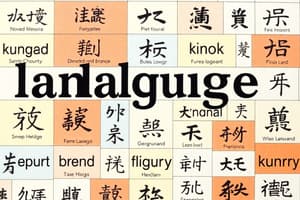Podcast
Questions and Answers
Cos'è la mediazione linguistica?
Cos'è la mediazione linguistica?
La mediazione linguistica si riferisce al processo di facilitazione della comunicazione tra individui o gruppi che parlano lingue diverse.
Cosa comprende la mediazione linguistica?
Cosa comprende la mediazione linguistica?
La mediazione linguistica comprende interpretazione e traduzione.
Quali sono i tre tipi di interpretazione menzionati nel testo?
Quali sono i tre tipi di interpretazione menzionati nel testo?
Consecutiva, simultanea, e di trattativa.
Cosa comporta l'interpretazione consecutiva?
Cosa comporta l'interpretazione consecutiva?
In che contesto viene comunemente utilizzata l'interpretazione simultanea?
In che contesto viene comunemente utilizzata l'interpretazione simultanea?
Quali abilità sono richieste per l'interpretazione simultanea?
Quali abilità sono richieste per l'interpretazione simultanea?
Qual è il processo di trasmettere il significato di un messaggio scritto o parlato da una lingua all'altra?
Qual è il processo di trasmettere il significato di un messaggio scritto o parlato da una lingua all'altra?
In che tipo di interpretazione l'interprete sussurra la traduzione alla persona seduta accanto?
In che tipo di interpretazione l'interprete sussurra la traduzione alla persona seduta accanto?
In quali settori è essenziale l'interpretazione, in quanto la cattiva comunicazione può portare a diagnosi o trattamenti errati?
In quali settori è essenziale l'interpretazione, in quanto la cattiva comunicazione può portare a diagnosi o trattamenti errati?
Perché è cruciale la traduzione nel contesto legale, come documenti giuridici e contratti?
Perché è cruciale la traduzione nel contesto legale, come documenti giuridici e contratti?
Qual è il ruolo della traduzione nel contesto delle opere letterarie?
Qual è il ruolo della traduzione nel contesto delle opere letterarie?
Perché è essenziale l'interpretazione in contesti aziendali, come riunioni internazionali?
Perché è essenziale l'interpretazione in contesti aziendali, come riunioni internazionali?
Qual è la differenza fondamentale tra interpretazione e traduzione?
Qual è la differenza fondamentale tra interpretazione e traduzione?
In quali contesti è essenziale l'interpretazione per garantire che tutti comprendano i procedimenti?
In quali contesti è essenziale l'interpretazione per garantire che tutti comprendano i procedimenti?
Perché è necessaria la traduzione nel contesto dei materiali di marketing e della documentazione tecnica aziendale?
Perché è necessaria la traduzione nel contesto dei materiali di marketing e della documentazione tecnica aziendale?
Perché è cruciale l'interpretazione nel contesto dell'istruzione, come scuole e università?
Perché è cruciale l'interpretazione nel contesto dell'istruzione, come scuole e università?
Flashcards are hidden until you start studying
Study Notes
Linguistic Mediation: Interpretation and Translation
Linguistic mediation refers to the process of facilitating communication between individuals or groups who speak different languages. This process involves two main subtopics: interpretation and translation. Both interpretation and translation are crucial in helping people understand each other and bridge linguistic and cultural gaps.
Interpretation
Interpretation is a process that involves the conveying of a spoken or signed message from one language to another. It is a live, dynamic process that requires interpretation skills, the ability to analyze and summarize the content, and the knowledge of the subject matter. There are three types of interpretation:
-
Consecutive Interpretation: This type of interpretation involves interpreting short messages or sentences in small chunks. The speaker speaks for a short while, and then the interpreter provides the translation.
-
Simultaneous Interpretation: This type of interpretation involves interpreting the speech in real-time. The interpreter needs to process and translate the speech while the speaker is still speaking. This type of interpretation requires advanced skills and is commonly used in international conferences and meetings.
-
Whispered Interpretation: This type of interpretation involves the interpreter whispering the translation to the person they are seated next to. This type of interpretation is commonly used in courtrooms, hospitals, and similar settings.
Interpretation is essential in a variety of settings, including:
-
Healthcare: Interpretation is crucial in medical settings, where miscommunication can lead to incorrect diagnoses or treatments.
-
Education: Interpretation is important in schools and universities to help students and teachers communicate effectively.
-
Legal: Interpretation is essential in legal settings, such as courts, to ensure that everyone understands the proceedings.
-
Business: Interpretation is necessary in business settings, such as international meetings, to facilitate communication between different parties.
Translation
Translation is the process of conveying the meaning of a written or spoken message from one language to another. It involves understanding the content, analyzing the context, and then translating the message into the target language. Translation is crucial in various fields, including:
-
Literature: Translation is necessary to share literary works across different languages and cultures.
-
Business: Translation is essential in business settings, such as marketing materials, contracts, and technical documentation.
-
Legal: Translation is crucial in legal settings, such as court documents and contracts, to ensure that everyone understands the content.
-
Healthcare: Translation is necessary in healthcare settings, such as patient records and medical literature, to ensure that everyone understands the content.
In conclusion, linguistic mediation is a crucial process that involves interpretation and translation. These processes are essential in facilitating communication between people who speak different languages and helping them bridge linguistic and cultural gaps. Interpretation is used for spoken or signed messages, while translation is used for written messages. Both processes are essential in various fields, including healthcare, education, legal, and business.
Studying That Suits You
Use AI to generate personalized quizzes and flashcards to suit your learning preferences.




